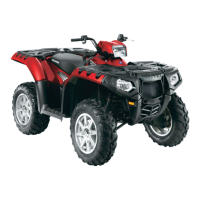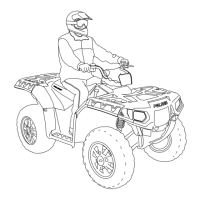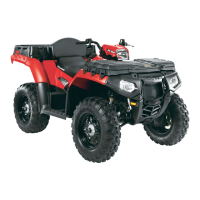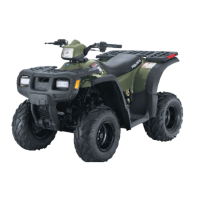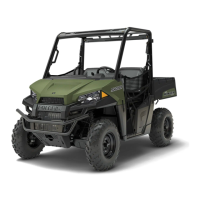Why is my Polaris 550 INDY LXT experiencing poor low RPM performance?
- CcamerongregorySep 23, 2025
If your Polaris Offroad Vehicle has poor low RPM performance, it could be due to: * Worn drive belt: Inspect and replace as needed.

Why is my Polaris 550 INDY LXT experiencing poor low RPM performance?
If your Polaris Offroad Vehicle has poor low RPM performance, it could be due to: * Worn drive belt: Inspect and replace as needed.
Why is my Polaris Offroad Vehicle engine hard to start and requires more than normal pulls?
If your Polaris Offroad Vehicle engine requires more than normal pulls to start, it could be due to: * Poor fuel: Replace with fresh winter fuel. * Not enough fuel getting to engine: See your dealer.
What to do if my Polaris 550 INDY LXT Offroad Vehicle engine doesn't start (electric start models)?
If your Polaris Offroad Vehicle engine doesn't start (electric start models), see your dealer to check the wire connections.
What to do if my Polaris 550 INDY LXT engine lacks power?
If your Polaris Offroad Vehicle engine lacks power, the possible causes are: * Fouled or defective spark plug(s): Replace the plug(s). * Fuel filter (loss of high RPM power): See your dealer. * Plugged fuel filter or tank pick-up sock: See your dealer. * Incorrect clutching: See your dealer. * Carburetor and fuel pump: See your dealer.
What causes noise in the drive system of my Polaris Offroad Vehicle?
Noise in the drive system of your Polaris Offroad Vehicle can be due to several reasons: * Broken drive clutch components: See your dealer. * Bearing failure in the chaincase, jackshaft, or front drive shaft: See your dealer. * Drive belt surface flat spots: Inspect and replace as needed. * Drive chain loose: Inspect and adjust (or replace). * Drive chain worn, sprocket teeth broken: See your dealer.
Why is there noise in the drive system of my Polaris 550 INDY LXT Offroad Vehicle?
Noise in the drive system of your Polaris Offroad Vehicle can be caused by: * Drive belt surface flat spots: Inspect and replace as needed. * Drive chain loose: Inspect and adjust (or replace).
What to do if my Polaris 550 INDY LXT Offroad Vehicle machine darts from side to side?
If your Polaris Offroad Vehicle darts from side to side: * Make sure spindles and all steering components turn freely. * Ensure skags are straight on skis.
Why does my Polaris 550 INDY LXT engine continually backfire?
If your Polaris Offroad Vehicle engine continually backfires, consider these potential causes: * Faulty plug(s): Change the plug(s). * Carburetor / Fuel System: Dirt or ice may be in the fuel system (add deicer to non-ethanol fuel at all times to prevent icing). * Incorrect throttle freeplay or faulty switch.
What causes a Polaris 550 INDY LXT Offroad Vehicle drive belt to turn over?
A Polaris Offroad Vehicle drive belt may turn over due to: * Wrong belt for application: Replace the drive belt. * Clutch alignment out of spec: See your dealer. * Engine mount broken or loose: Inspect and replace. See your dealer.
What causes harsh drive clutch engagement in my Polaris 550 INDY LXT?
Harsh drive clutch engagement in your Polaris Offroad Vehicle can be due to: * Drive belt worn or too narrow: Replace the drive belt. * Excessive belt/ sheave clearance: See your dealer.
| Brand | Polaris |
|---|---|
| Model | 550 INDY LXT |
| Category | Offroad Vehicle |
| Language | English |
Manual usage, maintenance program, and riding safety tips for owners and drivers.
Instructions for recording snowmobile identification and key numbers for reference.
Explanation of safety symbols, signal words (DANGER, WARNING, CAUTION, NOTICE) and sign types.
Guidance on safe driving, maintenance, avoiding modifications, and riding position.
Rider capacity and detailed safety instructions for operating with a passenger.
Awareness of obstacles, speed, weather, and responsible driving practices.
Information and warnings on safety labels placed on the snowmobile.
Diagram identifying key external parts of the snowmobile.
Diagram identifying controls on the handlebar, including switches and levers.
Overview of the instrument cluster, indicator lamps, and rider information center.
Instructions for adjusting headlights and passenger grab handles.
Guidance on adjusting front and rear suspension for optimal riding comfort and performance.
Details on traction products and handlebar adjustments for better control.
Comprehensive checklists and procedures for inspecting the snowmobile before operation.
Step-by-step guide for starting the snowmobile engine, including choke usage.
Procedures for engine break-in, fuel handling, and oil level maintenance.
Instructions for using electronic reverse and safe towing practices.
Schedule for regular maintenance and service checks, and owner responsibilities.
Details on brake, track, clutch, spark plug, and fluid maintenance.
Technical details, capacities, dimensions, and tuning charts for the snowmobile.
Charts for carburetor jetting and clutching based on altitude and temperature.
Diagnosing and solving common engine problems, causes, and solutions.
Solutions for rear suspension, steering, and drive belt related problems.
How to obtain warranty service and what information to provide to your dealer.
Overview of the limited warranty, its coverage, exclusions, and registration.
Details on the EPA emissions warranty, coverage, and owner responsibilities.


